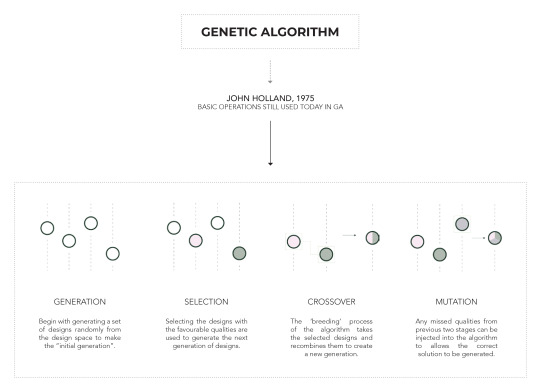Photo

Identifying a scale to take forward for ST2
2 notes
·
View notes
Photo



Up to this point, our boundary was set quite arbitrarily, taking very minimal parameters, if any, to create the boundary for the design space. By using a series of logic, as well as other factors that influence the site, we have narrowed down our potential design space. The first stage was to create an offset from nearby obstacles; those being the foliage on site and the bounding fence. A 2m offset was decided as this would allow adequate space for access around the design space. Our next step was to overlay a light study onto the site. The study encompassed the summer months; the time period in which the pavilion is functional, and through the light study and data gathered, we narrowed the design space further, to include areas of higher light concentrations, as going forward, this is one of the factors that will influence our programmatic approach. Having realised our design space, we also explored how the design space would impact one of our initial factors: views across the site. There are areas of the site that can only achieve a certain degree of view, whilst others allow for a full 360° view throughout the site and beyond. These spaces were mapped to site to give us an understanding of the location of the spaces that would allow the best views.
#architecture#cpuai#serpentine#pavilion#rhino#grasshopper#ladybug#isovist#iterativedesign#generativedesign
0 notes
Video
Furthering the research we did into human comfort coefficient to produce quantifiable programmatic areas, we wrote a script that would use another generative design grasshopper plugin, Galapagos. It takes the areas that have been calculated and iterates a series of spaces that fit those initial parameters and requirements. It continually iterates the design, improving it generation on generation until it reaches an optimum solution, that may not be exactly what is required but achieves values as close as possible. Whilst this script is in its initial stages, it has been mapped to our design space and further exploration from here would be to narrow the area down to within the design space, truly giving us a representation of the areas that we have the possibility to experiment with. This can also be intersected with the other grasshopper scripts to create a design space that is being influenced by a number of factors, rather than just the singular parameters that are influencing these scripts.
1 note
·
View note
Video

Experimenting with attractor based densities in grasshopper with outputs then taken from biomorpher. Next step is applying this to our generated site boundary.
2 notes
·
View notes
Photo

This diagram is based on a study by Ertürk, who defined several variables that impact human comfort, creating a quantifiable scale as an output. One of the parameters contributing to this is the density of interactions between users, which was equal to the total area divided by the number of users. The study outputs described the optimum human comfort levels and associated coefficients, and the value for density of interactions lies in the range of 2.63-2.80. This gives us a value to input into our design when defining the programmatic areas.
4 notes
·
View notes
Video
Another platform for generative design that we looked into, was using Biomorpher to create the forms of habitation. The Biomorpher plugin takes initial parameters and runs them through an evolutionary algorithm to create multiple generations of the design. The same parameters that fed the TT Toolbox plugin were used for Biomorpher, which then ran a series of iterations. From these, the most desirable iterations were selected (for this instance, the selected were routes that had an intersection with another route), and were used as the parents for the next generation of iterations. This could continue indefinitely to produce the most efficient design as the plugin continually takes the best performing designs and breeds them to create better iterations. This would allow us to explore further the habitable areas, and experiment with the spaces that we could assign to those areas, through a number of different factors (floor area, light values, optimisation of views etc).
2 notes
·
View notes
Video
The next step for exploring the circulation paths was to move away from the manual design method and create a parametric and generative grasshopper script, with the ability to iterate hundreds of different routes through the site. The video above shows a little snippet of the script in action, with the initial parameters being fed into the TT Toolbox grasshopper plugin. A series of points had been mapped to the boundary of the design space, and the script was written so that there would be an active connection between two random points. The TT Toolbox plugin allowed each iteration of connection to be visualised. The next step from here would be to isolate the best iteration outcome and move forward with that as a basis for the space, light and views exploration we have looked into.
0 notes
Photo

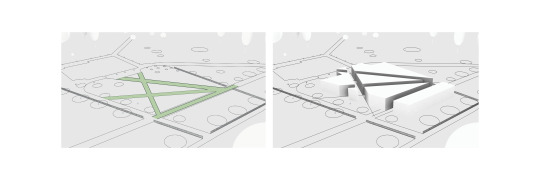
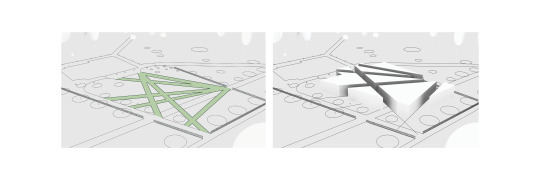


Our initial exploration into creating circulation routes through the site was a manual process. Based on a number of points that were placed in strategic positions (main areas of access and divisions of those), direct paths were drawn through the site to show how users may traverse the space. This was then transferred into Rhino to manipulate a initial design space to create areas of habitation and void areas of circulation. This method was iterated a number of times, varying the number of circulation routes through the site as well as the start and end points for the circulation paths.
1 note
·
View note
Photo



Experimenting with the view analysis in Grasshopper, we are looking at how each alternative starting point impacts the field of view.
1 note
·
View note
Photo
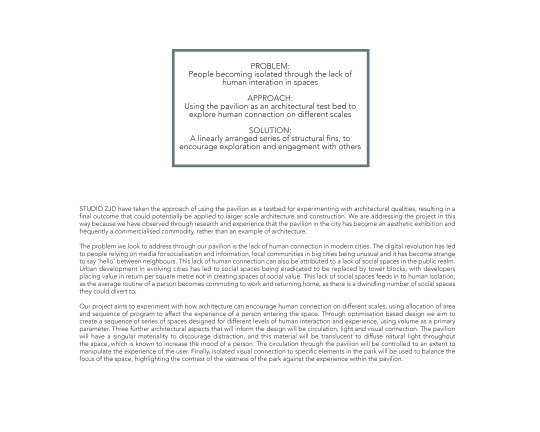
An update on our project drivers and projected direction.
2 notes
·
View notes
Photo

Continuing with natural light as one of our key metrics, we’ve used Ladybug to create a shadow study of the Serpentine site. This metric will be layered with our viewpoint and circulation data creating outputs to inform our design starting points.
0 notes
Photo

Inorganic Speciation talks about how, through the evolutionary and generative design, the way architectural form is created has changed and how the Supermanoeuvre company have adapted. What used to be the traditional process of manual design morphed into parametric design with the introduction of computer technologies into architecture. The next step is generative design, where the algorithm that runs the process is integrated at the start of the design process. This allows the form to escape the bounds of reality, a factor that heavily impacts the ability to and creativity of design. The generative design algorithm creates an architectural theory in which the form is founded, leading to the creation of architecture that is perfect for the given inputs.
[Theory 2 - Inorganic Speciation, Supermanoeuvre]
1 note
·
View note
Photo
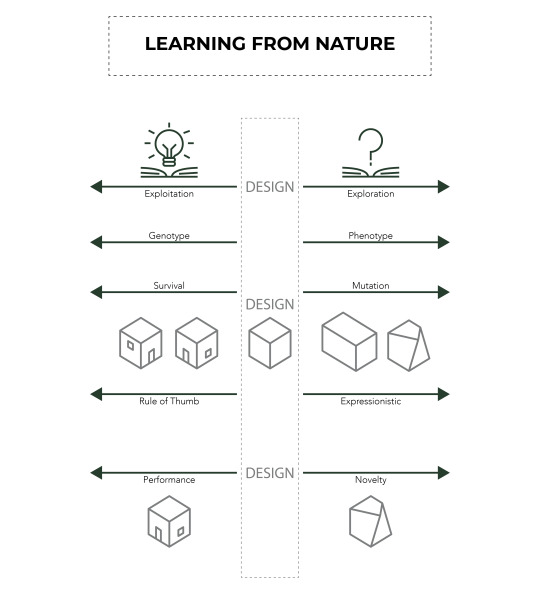
There are always two sides to each story, and the same is present within nature. Survival and mutation could be construed as going hand in hand, but they can also operate distinctly. In the context of design, Survival is looking at how a design can be exploited to its highest degree, keeping to the same initial design. This is essentially the mentality of “Why change something if it isn’t broken?”. It allows for generative and iterative design, but still falls short of where the design could be taken to another level. Mutation is when the design is on the other side, constantly changing to adapt and creating new species with each iteration. This can be in response to changes in the environment, changing the design from a genotype to a phenotype. For the most part, survival designs are based on existing knowledge and rule of thumb, where simplicity can result in the optimal design for performance. Mutation within design results in novel designs, where performance is sacrificed for expressionistic architecture.
[Theory 1 - Learning from Nature]
1 note
·
View note
Photo
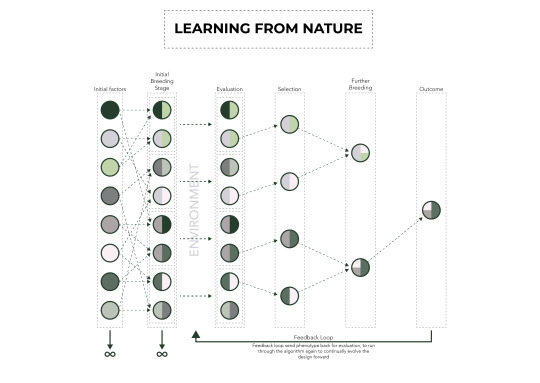
Nature can provide many inspirations for architectural design, and in many instances, bio-mimicry provides the bridge for nature to reach architecture. However, architectural form driven by bio-mimicry can be construed as quite superficial, not taking full advantage of what nature has to offer. Generative design has roots in nature, being observed to a large extent in the theory of evolution. First coined by Charles Darwin, it describes how the strongest of a species survives to breed and provide offspring for future generations. The same can be applied to generative design, where initial factors can breed to result in designs that can be selected, bred and mutated to allow designs that fulfil multiple design issues. These are then sent back via a feedback loop to examine the feasibility of the design within the same or new environments, thus creating a series of design processes that result in the best possible design.
[Theory 1 - Learning from Nature]
2 notes
·
View notes

